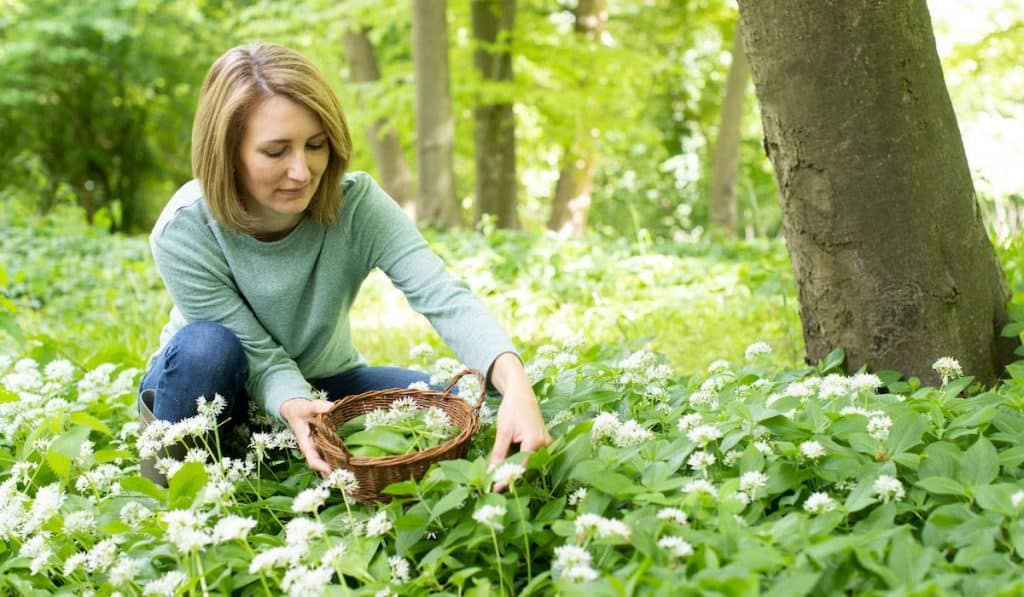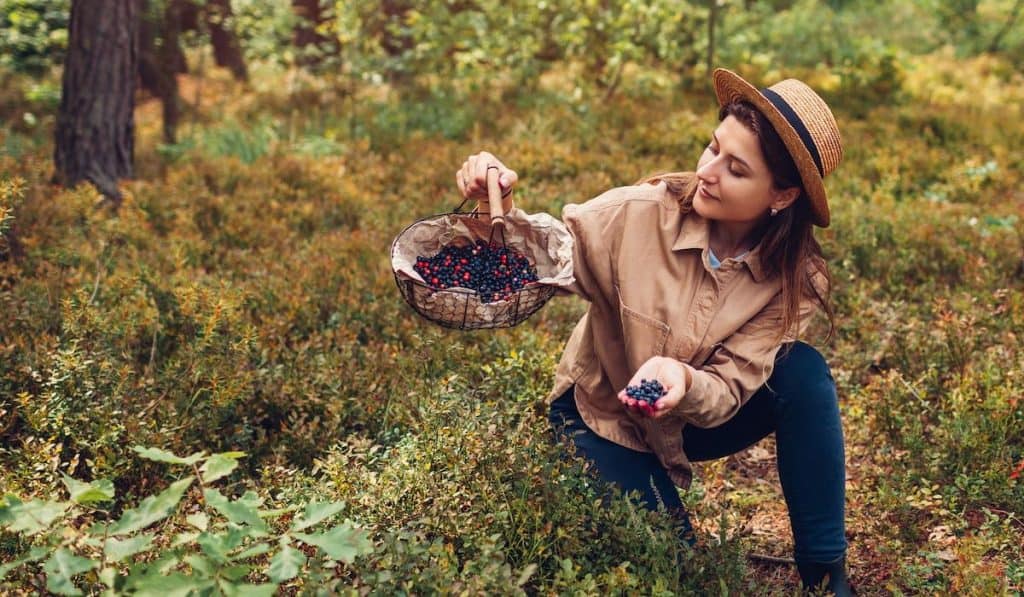Simply put, foraging is the act of gathering wild foods from the outdoors. It’s a lovely nature activity that many do as a hobby, to enjoy new, interesting, delicious, and nutritious foods. It has also been used since the earliest human history as a means of survival.
Foraging is fun, tasty, and if you find yourself without food in the woods, it can even be a lifesaver. So, how do you do it?
What Can You Forage?
You’d be surprised at the abundance of wild food that nature has to offer. If you know how to look, you can find edible (and often delicious) berries, tree-fruits, greens, flowers, mushrooms, tree-leaves and buds, and more!
Flowers
Did you know that many kinds of flowers are edible? Fresh, these add a burst of color to salads, and they can be cooked into stir-fries, too. Foraged flowers can even be sugared for dessert toppings or turned into jellies and syrups.
As always, make sure to only pick edible flowers, as there are many toxic ones that can pose a real danger.

Edible flowers are usually rich in antioxidants and vitamin C, but they’re prized for their fragrance and flavor. So, what are some common edible flowers that you can forage?
- Violets
- Roses (petals only)
- Dandelions
- Lilacs
- Wood Sorrel
- Red Clover
- Redbuds
- Black Locust
- Forsythia
- Wisteria (only the flowers, the rest of the plant is highly toxic)
Wild Greens
There are no greens quite so fresh and zesty as those grown in the forest. When harvested at the proper time, many forest greens are not only edible, but tasty, tender, and sweet in flavor.
Wild greens can be tossed in salads or enjoyed in sandwiches for the fresh-picked crispness and novel flavor.
Or, you can cook them in soups, add them to a stir fry, or whip them up into ultra-healthy smoothies.
Wild greens are a fantastic source of many nutrients, such as vitamins A and K, potassium, magnesium, and of course, all-important fiber.
So, what are some common edible greens that you can forage?
- Dandelion (greens)
- Chickweed
- Chicory
- Dock
- Mallow
- Lamb’s Quarter
- Grape Leaves
Take a look at some of the best places in the US to forage. Read our guide.
Tree Leaves and Buds
Many tree leaves are suitable for eating in the springtime. In fact, you can even eat them as buds, if you are curious or desperate. The leaves vary from sweet to bitter, and the buds are usually sticky-sweet.
Tree leaves can be mixed into salads and put on sandwiches. The thick, crunchy ones even go great in stir-fry. Pine and Spruce are typically most palatable in the form of a tea.

Most tree leaves contain trace vitamins, natural sugar, and heaps of fiber. Pine tips are also chock-full of vitamin C!
So, what are some common edible tree leaves and buds?
- Cottonwood (buds)
- Spruce (buds/tips)
- Black Birch
- Yellow Birch
- Willow
- Maple
- Chinese Elm
- Hawthorn
- Mulberry
- Linden
Edible Wild Fruit
Be warned: there are a lot of poisonous fruits in the forest, and some are lookalikes of edible fruits. Only eat what you are entirely sure of.
Fortunately, blackberries, raspberries, and strawberries have no known lookalikes. So if you see these, don’t hesitate to pick a few!
Wild fruit is suitable for many of the same things that store-bought or home-grown fruit is. In fact, sometimes it’s even tastier. You can turn foraged fruits and berries into jams, syrups, pies, smoothies… you name it.
For example, rosehips, the fruit that comes after the roses, are renowned for their cherry and rose flavor. They are also an excellent source of vitamin C, as are many berries. In fact, just about every kind of edible fruit contains vital nutrients, such as vitamin A and lots of gut-loving fiber. They’re also delicious; what more can you ask?
So, what are some common edible wild fruits?
- Ground cherries
- Rosehips
- Apples
- Blackberries
- Raspberries
- Blueberries
- Marionberries
- Bilberries
- Cloudberries
- Cherries
- Gooseberries
- Cranberries
Edible Wild Nuts and Roots
Nuts and roots are less common than other foraged goods, with nuts appearing only once a year in the late summer. You may be fortunate to find some, however.
Nuts can be a great source of healthy fats (translation: quick energy), and roots are packed with starches and fiber. So, what are some common edible nuts and roots?
- Black Walnuts
- Pecans
- Butternuts
- Acorns
- Pine nuts
- Burdock (roots)
- Cattail (roots)
- Chicory (roots)
- Daylily (roots)
Edible Mushrooms
Edible wild mushrooms can be eaten plain and are also perfect for soups and stir-fries. They will add a hearty texture and are excellent at absorbing flavor (some also like the earthy flavor of mushrooms themselves).

Of course, mushrooms can be incredibly toxic (even deadly) as well, and there are some sneaky lookalikes. You’ll have to be very careful. Here are some of the most common (and most easily identifiable) edible mushrooms:
- Puffball Mushrooms
- Oyster Mushrooms
- Chicken of the Woods
- Lobster Mushrooms
- Lion’s Mane
- Morrell (not to be mistaken with False Morrell)
- Maitake Mushrooms (also known as Sheep’s Head Mushrooms)
Tree Cambium and Tree Bark
Have you ever heard of tree cambium? This is the soft inner flesh of the tree, located deep beneath the bark. You can access it by peeling and carving the bark away an inch or two. Of course, you only want to do this in small portions, except in dire need.
Many trees contain edible cambium, and a few even have edible bark! So, what are some common trees with edible cambium and/or bark?
- Red Spruce
- Black Spruce
- White Pine (and most but not all types of pine)
- Black Birch
- Yellow Birch
- Slippery Elm
- Maple
- Balsam Fir
What Supplies Do You Need for Foraging?
Foraging couldn’t be easier. All that you need is a good foraging spot, such as a meadow or forest, shears (or a similar cutting tool), and a basket (or two). Some will also opt to bring gloves, to protect from thorns and berry stains.
As with any trip to the outdoors, you should bring water and preferably a snack, and bug spray may also be called for!
Click here to read our guide to Foraging tools that you’ll need
Toxic Plants to Watch Out For
Many plants are toxic, while considerably less of them are edible. With this in mind, before you get started foraging, you absolutely must have the proper know-how! Following are some of the most common toxic plants and lookalikes you will need to watch out for:
- Doll’s Eyes
- Monkshood
- False Morrel (a Morrel lookalike)
- Moonseed (a grape lookalike)
- Stinking Nettle (you’re sure to have heard of it)
- Cherry leaves and cambium (only the fruit is edible)
- Manchineel (fruit, leaves, roots, and bark)
- Wild Hemlock (a wild carrot lookalike)
- False Garlic (a wild garlic lookalike)
- Sweet Amber Berries (a blueberry lookalike)
- Deadly Nightshade Berries (a Black Nightshade lookalike and probably best avoided altogether)
- Death Caps Mushrooms
- Jack O Lantern Mushrooms (a Chicken of the Woods lookalike)
When Can You Forage?
The best times to forage are late summer and early autumn when the harvest season is in full swing. In northern climes, this is when you can find ripe fruit, nuts, and even flowers.
There are also some early foods available in the spring, such as seasonal flowers (like redbuds), greens, tree leaves, and buds. There are even a few foodstuffs that the canny forager can find in the winter.
In southern climes, you may find yourself with access to certain greens and fruits all year!
Here is a link to our Complete Guide to Foraging as a hobby. Take a look
What Can You Make Out of Foraged Food?
Foraged food can make an exotic, nutritious accompaniment to almost any dish. You can make soups, salads, sandwich toppings, jams, jellies, pies, stir-fries, and more!
How to Forage Respectfully
While foraging, make sure to do it respectfully and avoid damage to plants and undergrowth. Never forage more than ¼ of what is in any given area (unless it is an emergency and that’s all there is).
Cambium should be harvested only seldom, as the tree depends on this food source itself. Finally, don’t leave behind any litter (and if you feel so inclined, pick up any you might see).
As you can see, there’s a whole world of foraged foods out there (and dishes you can make from them). Just make sure you know which plants to avoid and which to look for!




